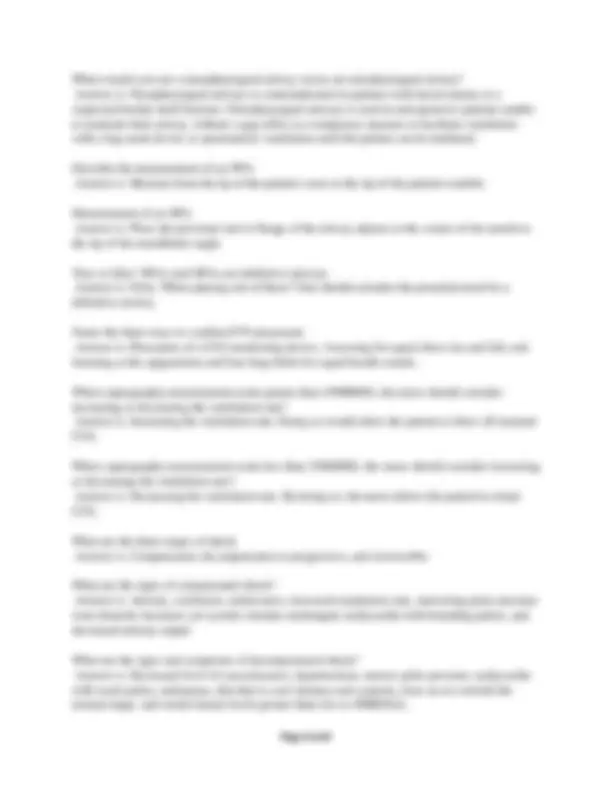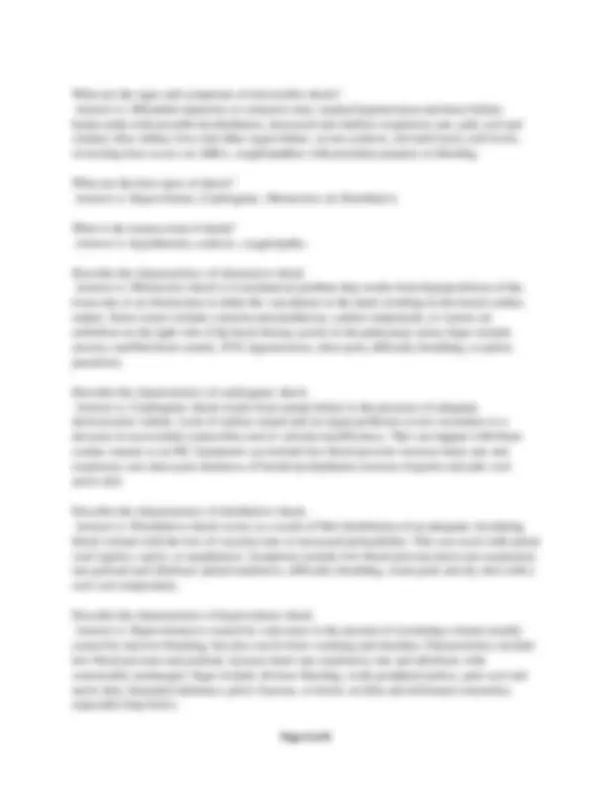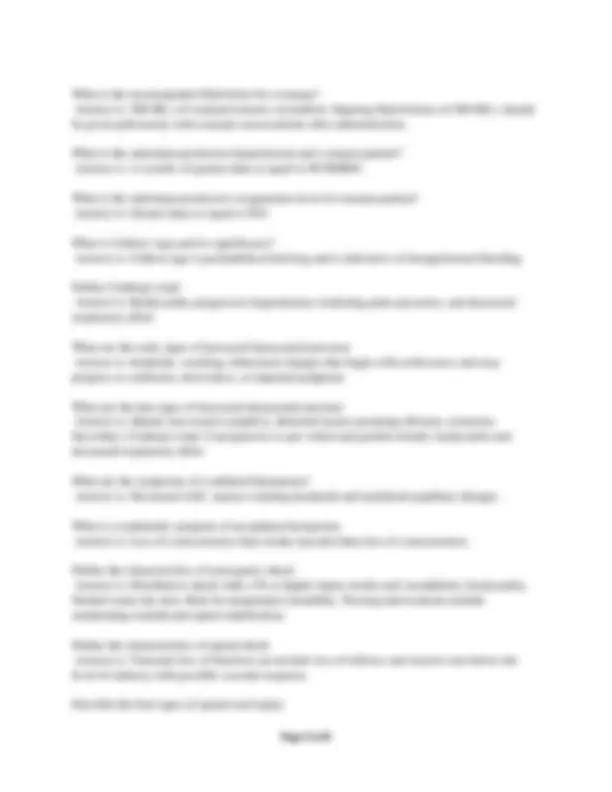





Study with the several resources on Docsity

Earn points by helping other students or get them with a premium plan


Prepare for your exams
Study with the several resources on Docsity

Earn points to download
Earn points by helping other students or get them with a premium plan
Community
Ask the community for help and clear up your study doubts
Discover the best universities in your country according to Docsity users
Free resources
Download our free guides on studying techniques, anxiety management strategies, and thesis advice from Docsity tutors
What are the greatest risks for transport? Answer is: Loss of airway patency, displaced obstructive tubes lines or catheters, dislodge splinting devices, need to replace or reinforce dressings, deterioration in patient status change in vital signs or level of consciousness, injury to the patient and/or team members According to newtons law which of these two force is greater: size or force? Answer is: Neither. For each force there is an equal and opposite reaction. What is the relationship between mass and velocity to kinetic energy? Answer is: Kinetic energy is equal to 1/2 the mass multiplied the square of its velocity therefore when mass is doubled so is the net energy, however, when velocity is doubled energy is quadrupled. What is tension? Answer is: stretching force by pulling at opposite ends What is compression? Answer is: Crushing by squeezing together
Typology: Exams
1 / 6

This page cannot be seen from the preview
Don't miss anything!




What are the greatest risks for transport? Answer is: Loss of airway patency, displaced obstructive tubes lines or catheters, dislodge splinting devices, need to replace or reinforce dressings, deterioration in patient status change in vital signs or level of consciousness, injury to the patient and/or team members According to newtons law which of these two force is greater: size or force? Answer is: Neither. For each force there is an equal and opposite reaction. What is the relationship between mass and velocity to kinetic energy? Answer is: Kinetic energy is equal to 1/2 the mass multiplied the square of its velocity therefore when mass is doubled so is the net energy, however, when velocity is doubled energy is quadrupled. What is tension? Answer is: stretching force by pulling at opposite ends What is compression? Answer is: Crushing by squeezing together What is bending? Answer is: Loading about an axis. Bending causes compression on the side the person is bending toward intention to the opposite side What is shearing? Answer is: Damage by tearing or bending by exerting faucet different parts in opposite directions at the same time. What is torsion? Answer is: Torsion forces twist ends in opposite directions. What is combined loading? Answer is: Any combination of tension compression torsion bending and/or shear. What are the four types of trauma related injuries? Answer is: Blunt, penetrating, thermal, or blast. What are contributing factors to injuries related to blunt traumas? Answer is: The point of impact on the patient's body, the type of surface that is hit, the tissues ability to resist (bone versus soft tissue, air-filled versus solid organs), and the trajectory of force.
What are the seven patterns of pathway injuries related to motor vehicle accidents? Answer is: Up and over, down and under, lateral, rotational, rear, roll over, and ejection. Differentiate between the three impacts of motor vehicle impact sequence. Answer is: The first impact occurs when the vehicle collided with another object. The second impact occurs after the initial impact when the occupant continues to move in the original direction of travel until they collide with the interior of the vehicle or meet resistance. The third impact occurs when internal structures collide within the body cavity. What are the three factors that contribute to the damage caused by penetrating trauma's? Answer is: The point of impact, the velocity and speed of impact, and the proximity to the object. What causes the primary effects of blast traumas? Answer is: The direct blast effects. Types of injuries include last long, tympanic membrane rupture and middle ear damage, abdominal hemorrhage and perforation, global rupture, mild Trumatic brain injury. What causes the secondary effects of blast traumas? Answer is: Projectiles propelled by the explosion. Injuries include penetrating or blunt injuries or I penetration. What causes the tertiary effects of blast traumas? Answer is: Results from individuals being thrown by the blast wind. Injuries include hole or partial body translocation from being thrown against a hard service: blunt or penetrating trauma's, fractures, traumatic amputations. What causes quarternary effects of blast traumas? Answer is: All explosion related injuries, illnesses, or diseases not due to the first three mechanisms. Injuries include external and internal burns, crush injuries, closed and open brain injuries, asthmatic or breathing problems from dust smoke or toxic fumes, angina, or hyper glycemia and hypertension. What causes quinary effects of blasts traumas? Answer is: Those associated with exposure to hazardous materials from radioactive, biologic, or chemical components of a blast. Injuries include a variety of health effects depending on agent. What are the three processes that transfer oxygen from the air to the lungs and blood stream Answer is: Ventilation: the active mechanical movement of air into and out of the lungs; diffusion: the passive movement of gases from an area of higher concentration to an area of lower concentration; and perfusion: the movement of blood to and from the lungs as a delivery medium of oxygen to the entire body.
What are the signs and symptoms of irreversible shock? Answer is: Obtunded stuporous or comatose state, marked hypertension and heart failure, bradycardia with possible dysrhythmias, decreased and shallow respiratory rate, pale cool and clammy skin, kidney liver and other organ failure, severe acidosis, elevated lactic acid levels, worsening base access on ABGs, coagulopathies with petechiae purpura or bleeding. What are the four types of shock? Answer is: Hypovolemic, Cardiogenic, Obstructive, & Distributive What is the trauma triad of death? Answer is: hypothermia, acidosis, coagulopathy Describe the characteristics of obstructive shock Answer is: Obstructive shock is it mechanical problem that results from hypoperfusion of the tissue due to an obstruction in either the vasculature or the heart resulting in decreased cardiac output. Some causes include a tension pneumothorax, cardiac tamponade, or venous air embolism on the right side of the heart during systole in the pulmonary artery.Signs include anxiety, muffled heart sounds, JVD, hypertension, chest pain, difficulty breathing, or pulses paradoxes. Describe the characteristics of cardiogenic shock Answer is: Cardiogenic shock results from pump failure in the presence of adequate intravascular volume. Lack of cardiac output and an organ perfusion occurs secondary to a decrease in myocardial contractility and or valvular insufficiency. This can happen with blunt cardiac trauma or an MI. Symptoms can include low blood pressure increase heart rate and respiratory rate chest pain shortness of breath dysrhythmias increase troponin and pale cool moist skin Describe the characteristics of distributive shock. Answer is: Distributive shock occurs as a result of Mel distribution of an adequate circulating blood volume with the loss of vascular tone or increased permeability. This can occur with spinal cord injuries, sepsis, or anaphylaxis. Symptoms include low blood pressure heart rate respiratory rate preload and afterload, spinal tenderness, difficulty breathing, warm pink and dry skin with a cool core temperature. Describe the characteristics of hypovolemic shock Answer is: Hypovolemia is caused by a decrease in the amount of circulating volume usually caused by massive bleeding, but also can be from vomiting and diarrhea. Characteristics include low blood pressure and preload, increase heart rate respiratory rate and afterload, with contractility unchanged. Signs include obvious bleeding, weak peripheral pulses, pale cool and moist skin, distended abdomen, pelvic fracture, or bruise swollen and deformed extremities especially long bones.
What is the recommended fluid bolus for a trauma? Answer is: 500 ML's of warmed isotonic crystalloid. Ongoing fluid boluses of 500 ML's should be given judiciously with constant reassessments after administration. What is the minimum permissive hypertension and a trauma patient? Answer is: A systolic of greater than or equal to 90 MMHG What is the minimum permissive oxygenation level of a trauma patient? Answer is: Greater than or equal to 94% What is Cullen's sign and its significance? Answer is: Cullens sign is periumbilical bruising and is indicative of intraperitoneal bleeding Define Cushing's triad Answer is: Bradycardia, progressive hypertension (widening pulse pressure), and decreased respiratory effort What are the early signs of increased Intracranial pressure Answer is: headache, vomiting, behavioral changes that begin with restlessness and may progress to confusion, drowsiness, or impaired judgment What are the late signs of Increased intracranial pressure Answer is: dilated, non-reactive pupil(s); abnormal motor posturing (flexion, extension, flaccidity); Cushing's triad, Unresponsive to per verbal and painful stimuli, bradycardia and decreased respiratory effort What are the symptoms of a subdural hematoma? Answer is: Decreased LOC, nausea vomiting headache and ipsilateral pupillary changes What is a trademark symptom of an epidural hematoma Answer is: Loss of consciousness then awake and alert then loss of consciousness Define the characteristics of neurogenic shock Answer is: Distributive shock with a T6 or higher injury results and vasodilation, bradycardia, flushed warm dry skin. Risk for temperature instability. Nursing interventions include maintaining warmth and spinal stabilization. Define the characteristics of spinal shock Answer is: Transient loss of function can include loss of reflexes and muscle tone below the level of industry with possible vascular response. Describe the four types of spinal cord injury